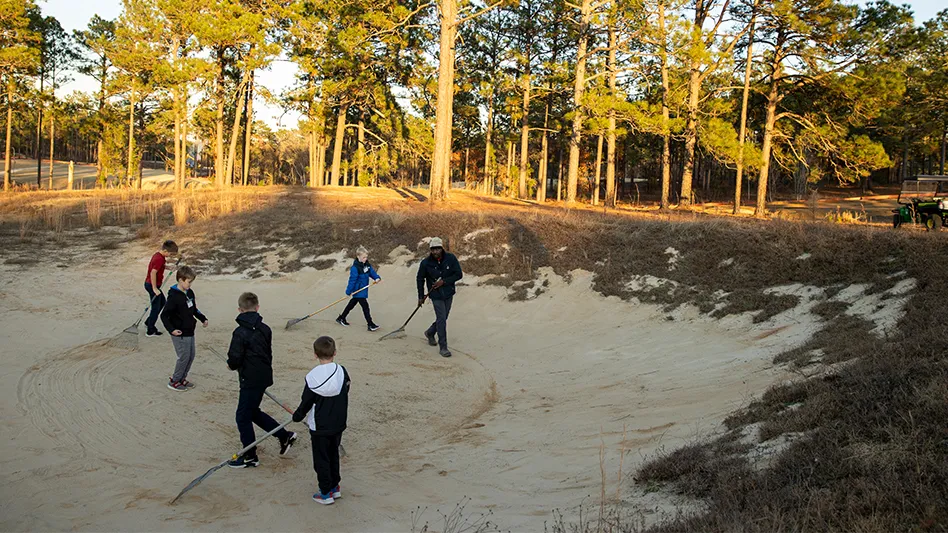


The magnitude of Shawn Bergey’s job emerges when he begins quantifying the volume of equipment his team of three mechanically minded workers maintains.
He begins with fairways, the widest and longest swaths of maintenance-intensive turf at the Philadelphia Cricket Club, a 45-hole, two-campus private facility supporting golf and other pleasant turf trimmings in southeast Pennsylvania. The club possesses eight fairway mowers to cut 75½ acres.
Bergey shifts to what he calls “large” rough units. Four.
He transitions to “small” rough units. Three.
More counting aloud and further quantifying follow. He pauses a few times, including when he realizes the club utilizes two dozen walking greens mowers.
Finally, after 158 seconds of reciting and remembering, the list exceeds more than 200 engine-propelled units.
“It’s crazy when you start putting numbers to stuff,” says Bergey, a former assistant superintendent now in his third full year as Philadelphia Cricket Club’s equipment manager.
As golf continues to surge and conditioning demands increase, the value of a proven equipment manager has never been higher. Somebody, after all, needs to keep that pricey equipment operating at high levels.
Bergey is fortunate. Philadelphia Cricket Club receives equipment via four- and five-year lease cycles. Turf isn’t actively growing year-round in Philadelphia — yet. The club employs two assistant equipment technicians to help Bergey. His boss also understands the importance of investing in the equipment manager position.
“You can have all these philosophies about what you want to do,” says Philadelphia Cricket Club chief planning officer and director of grounds Dan Meersman, “but unless you have somebody who’s skilled enough to pull it off, you can’t produce the quality of product that your membership might expect.”
of ALL THE labor issues facing golf, none is as debilitating to the industry as a shortage of qualified equipment managers. A mega-club such as Philadelphia Cricket Club can absorb the angst of a mower hitting a rock or suffering a hydraulic leak. The margins between a tidy day or a messy day, week or month are slimmer elsewhere.
“What we do is extremely important,” says Bryan Epland, the equipment manager at ArborLinks in Nebraska City, Nebraska. “I won’t be humble about that at all. If you’re somebody who doesn’t have an assistant and maintains a fleet as big as I do, it would be tough to get away period any time during the growing season.”
The fleet Epland maintains includes more than 60 units. Like many facilities, ArborLinks has experienced play and revenue boosts over the past three years. Recent investments include a new topdresser and tractor. Both units will elevate the product ArborLinks offers members. Both products also require regular maintenance. During the peak season, the ArborLinks crew swells to around 30 employees, many of whom Epland must help train on equipment usage and care.

Epland is currently developing an assistant, Kelson Griever, to help handle the additional workload. Griever arrived at ArborLinks earlier this year with no mechanical experience. Eric Rebman made the switch from mowing Philadelphia Cricket Club’s turf to maintaining the equipment that mows the club’s turf after Bergey noticed Rebman showed interest in happenings around the shop. Before Bergey landed the head equipment manager role at Philadelphia Cricket Club, he was the lone year-round employee devoted to equipment maintenance at nearby Llanerch Country Club.
“Working without an assistant is very tough,” he says. “It’s more like, ‘What are you expected to do as one person? Are you going to get your butt reamed out if there’s oil all over the fairway? If so, as a one-man show, you can’t be out there following everybody.”
Bergey and Epland experienced quick ascents to desirable equipment manager jobs. Bergey previously worked as an assistant superintendent until 2015; Epland worked as an automotive mechanic until 2016.
Quick career rises are possible because experienced turf equipment managers are increasingly difficult to find. Tyler Bloom, founder of the talent acquisition and workforce development firm Tyler Bloom Consulting, added equipment managers to his placement services in 2021 because demand for proven equipment managers in a more demanding golf market has surpassed the talent supply.
“That role has been elevated beyond just being an equipment manager,” says Bloom, a former superintendent who started his business in early 2020. “They are helping with facilities. In some cases, they might be out working on the golf course because you don’t have enough staff. They are managing people and they are a part of the onboarding of new employees.
“The demand now is not just for the technical and turning wrenches component. It’s actually more from the organizational standpoint because it’s become a much higher-level position.”
Once somebody develops the versatile skillset, opportunities to change equipment manager jobs are plentiful. Joe Moreira recently accepted the equipment manager position at Etowah Valley Golf Club & Lodge in western North Carolina after six years in the same role at Lake Toxaway Country Club. The marketability of his skills started resonating with Moreira — who made $16 per hour in his first industry job a decade ago — when he left his native Florida for Lake Toxaway. “It became something I knew I would do as a career when about six years ago I realized I could write my own terms,” Moreira says.
Moreira experienced the current demand for equipment management skills in the job search that ended with him landing at Etowah Valley, a 27-hole facility 30 miles from Lake Toxaway. Through the years, he’s received offers from courses in nearly every part of the United States and encountered opportunities in other countries, including the Dominican Republic and Costa Rica.
“This has become a niche of a career. Not a lot of people are getting into, unfortunately,” he adds. “It allows me to get into these bigger golf courses. I’m younger and the old-timers have been getting out of it. When I found out I could write my own ticket, that’s when I said, ‘I could do this forever.’”
The confluence of added job responsibilities, heightened conditioning expectations, a limited talent pool and competition from other industries seeking experienced mechanical talent is forcing golf facilities to invest more into the equipment manager position.
Retired superintendent and industry historian Mel Lucas Jr. says he paid “mechanics” 50 cents more per hour than crew members when a need for the position developed in the early 1970s. The gap between operators and equipment managers has significantly widened in the past 50 years. The GCSAA job board listed more than 30 open equipment manager positions in early August, with pay for experienced candidates ranging from $18 per hour at an 18-hole course in Missouri up to $145,000 per year at a new 48-hole private facility in Georgia.
“With what they have to deal with today, if there’s a club that doesn’t have a qualified mechanic, then they are far from being on the top,” Lucas says. “You really need to have a top-quality person as a mechanic at a club. They are worth their weight in gold. Whatever they make, they deserve.”
The value of the position becomes further evident when hearing equipment managers — an innately humble group of professionals — describe what they do in their own words.
Epland: “I would just call myself the dirty hands guy. In a nutshell, you’re a mechanic, you’re a welder, you’re a plumber, you’re a carpenter.”
TPC Tampa Bay’s Ken Nail: “I repair, fix and babysit everything it takes to maintain a golf course, from machines, to toilets, to ice machines, to the crew.”
Kenosha (Wisconsin) Country Club’s Justin Prescott: “As far as the golf course, I like to joke that the superintendent is good at growing grass, but I’m good at cutting grass.”
The role wasn’t always this complex — or this tough to fill.
The equipment manager position, according to Lucas, a second-generation superintendent and author of “Golf’s Cause and Effect: A History of Greenkeeping,” started becoming widespread in the late 1960s and early ’70s. The position’s emergence coincided with the introduction of mowers with hydraulic lifts to adjust cutting heights in the ’60s.
“The new breed of superintendents that came out of places like Penn State and UMass recognized they were professionals and that they had to be more professional in their chosen field,” Lucas says. “They weren’t really mechanics. And when hydraulics started to come into golf course equipment, that was a little more overwhelming to the majority of golf course superintendents. They recognized these machines needed somebody to care for them because they were costing a lot of money.”
Referred to as “mechanics” by Lucas and his peers, the new employees being integrated into golf maintenance operations were relatively easy to find, especially in densely populated places. Lucas, for example, led turf teams on Long Island, where advertisements in daily newspapers such as Newsday often attracted a surplus of qualified candidates. “It wasn’t just me,” he says. “All the big clubs were finding mechanics who wanted to be mechanics on a golf course.”
What happened to golf isn’t much different than what occurred in the ensuing decades in other industries requiring people with mechanical backgrounds. “Let’s face it,” Lucas says, “kids, even into my era, the 1950s and 1960s, when you got your car, you were working on it. That isn’t the case today.”
Prescott is a modern anomaly. The son of a Wisconsin firefighter who also taught classes at a Gateway (Wisconsin) Technical College, Prescott says his father, Michael Prescott Sr., instilled a passion in him for learning hands-on tasks, including mechanics.
“I hate to be that person that goes, ‘Oh well, everybody is on their phone or computer now,’” Justin says. “Well, I had that stuff growing up. We had a computer my entire life and I had video games, but I still wanted to go outside. I wanted to be in nature, I wanted to be in the garage and the shop.”
Prescott’s jobs as a teenager ranged from working at a restaurant to a maintenance position at a Bible camp. Prescott then received a building maintenance job at Alpine Valley Resort in Elkhorn, Wisconsin, that required him to help on the ski hill. He joined the resort’s golf maintenance crew in his early 20s and ascended to an assistant superintendent position before seeking a career change. Prescott enrolled in welding school and quickly learned the trade wasn’t for him. He returned to golf in his mid-30s as the equipment manager at Kenosha Country Club.
Possessing a mechanical background helped Justin obtain a comfortable job at a respected club less than an hour from his hometown. “Once you get that experience, the jobs are out there,” he says. “They come up quite often.”
Multiple people interviewed for this series cited less exposure to mechanical and technical fields in secondary schools as a reason for a shortage of qualified equipment managers in golf and other industries. Career and technical education (CTE) credits earned by United States high school students dropped by 14 percent between 1990 and 2009, according to the National Center for Education Statistics.
“One thing that doesn’t sit well with me is that our high schools are taking away the wood and metal shop and those kinds of programs,” Justin says. “It kind of scares me, because these vocational trades need to be taught just the same as all the other things that they are sending kids off to school for. They are trying to put a closed-focused way of life into every kid’s mind instead of adapting to help kids find their path.”
As larger societal changes continue to filter into golf course maintenance, finding and keeping solid equipment managers will continue to challenge the industry.
More play. More complex mowers. Lower heights of cut. Fewer qualified people to tie it all together.
“Ultimately, it’s supply and demand,” Philadelphia Cricket Club’s Meersman says. “For the few people who want to learn how to do this the right way, there will be a really good market for those individuals.”

Explore the September 2023 Issue
Check out more from this issue and find you next story to read.





